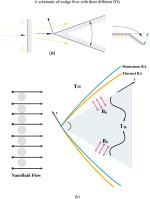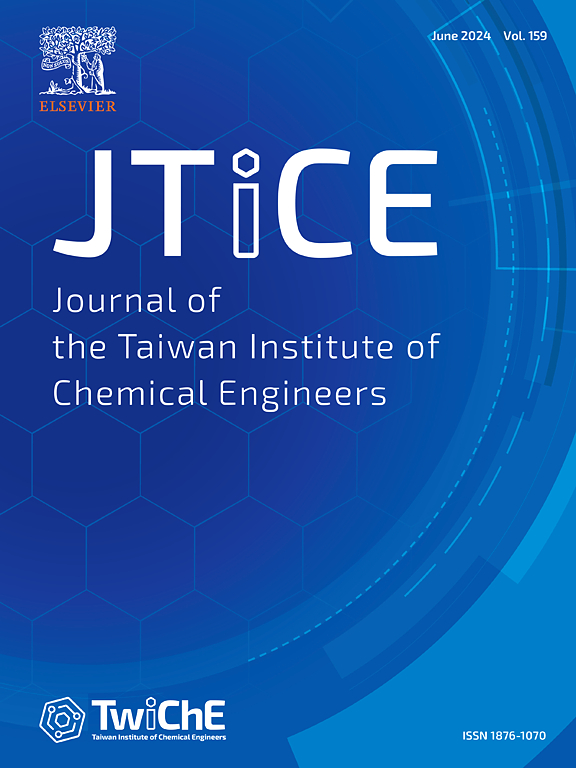Optimization and sensitivity analysis of magnetic fields on nanofluid flow on a wedge with machine learning techniques with joule heating, radiation and viscous dissipation
IF 5.5
3区 工程技术
Q1 ENGINEERING, CHEMICAL
Journal of the Taiwan Institute of Chemical Engineers
Pub Date : 2024-11-15
DOI:10.1016/j.jtice.2024.105813
引用次数: 0
Abstract
Purpose
In this study, the flow of nanofluids (NFDs), consisting of water and copper nanoparticles over a wedge, is simulated. The analysis considers the effects of a magnetic field (MFD) and Joule heating (JOH). Variables such as nanoparticle volume fraction (NVF), Eckert number (EC), radiation, and wedge angle (BT) are also examined for their impacts on the Nu and Cf.
Design/methodology/approach
The simulation utilizes the similarity method and the Keller box method, implemented through custom coding. Additionally, machine learning techniques are applied for sensitivity analysis and optimization of the results by varying the parameters.
Findings
The findings indicate that increasing the BT, NVF and MFD strength can elevate the average friction coefficient (Cf-m) by up to 42.8 %. Sensitivity analysis reveals that factors like BT and MFD significantly influence the Cf-m and Nu. An increase in MFD strength generally reduces the Nu-m. A larger BT substantially boosts the Nu-m; however, heightened JOH results in a sharp decline in the Nu. An increase in the EC leads to a decrease in the Nu-m. At low radiation parameter (RD) values, increasing this parameter reduces the Nu-m, whereas at higher values, it increases the Nu.
Originality/value
The key contribution of the article is the optimization and sensitivity analysis of NFD flow over a surface, considering the effects of a MFD, JOH, radiation, EC, and BT. This is done to achieve maximum heat transfer and minimum friction loss.

利用机器学习技术优化磁场对楔形纳米流体流动的影响并进行敏感性分析,同时考虑焦耳加热、辐射和粘性耗散问题
目的 本研究模拟了由水和纳米铜粒子组成的纳米流体(NFDs)在楔形上的流动。分析考虑了磁场(MFD)和焦耳加热(JOH)的影响。还研究了纳米粒子体积分数 (NVF)、埃克特数 (EC)、辐射和楔角 (BT) 等变量对 Nu 和 Cf 的影响。研究结果研究结果表明,增加 BT、NVF 和 MFD 强度最多可将平均摩擦系数 (Cf-m) 提高 42.8%。敏感性分析表明,BT 和 MFD 等因素对 Cf-m 和 Nu 有显著影响。MFD 强度的增加通常会降低 Nu-m。更大的 BT 会大幅提高 Nu-m;然而,JOH 的增加会导致 Nu 的急剧下降。EC 的增加会导致 Nu-m 的下降。在辐射参数 (RD) 值较低时,增加该参数会降低 Nu-m,而在辐射参数 (RD) 值较高时,则会增加 Nu。这样做是为了实现最大的热传递和最小的摩擦损失。
本文章由计算机程序翻译,如有差异,请以英文原文为准。
求助全文
约1分钟内获得全文
求助全文
来源期刊
CiteScore
9.10
自引率
14.00%
发文量
362
审稿时长
35 days
期刊介绍:
Journal of the Taiwan Institute of Chemical Engineers (formerly known as Journal of the Chinese Institute of Chemical Engineers) publishes original works, from fundamental principles to practical applications, in the broad field of chemical engineering with special focus on three aspects: Chemical and Biomolecular Science and Technology, Energy and Environmental Science and Technology, and Materials Science and Technology. Authors should choose for their manuscript an appropriate aspect section and a few related classifications when submitting to the journal online.

 求助内容:
求助内容: 应助结果提醒方式:
应助结果提醒方式:


